In northwestern Poland, right by the border with Germany, there is a commune that has made its mark on greenery. There are rumors that it's all to avoid becoming an island. Intriguing?
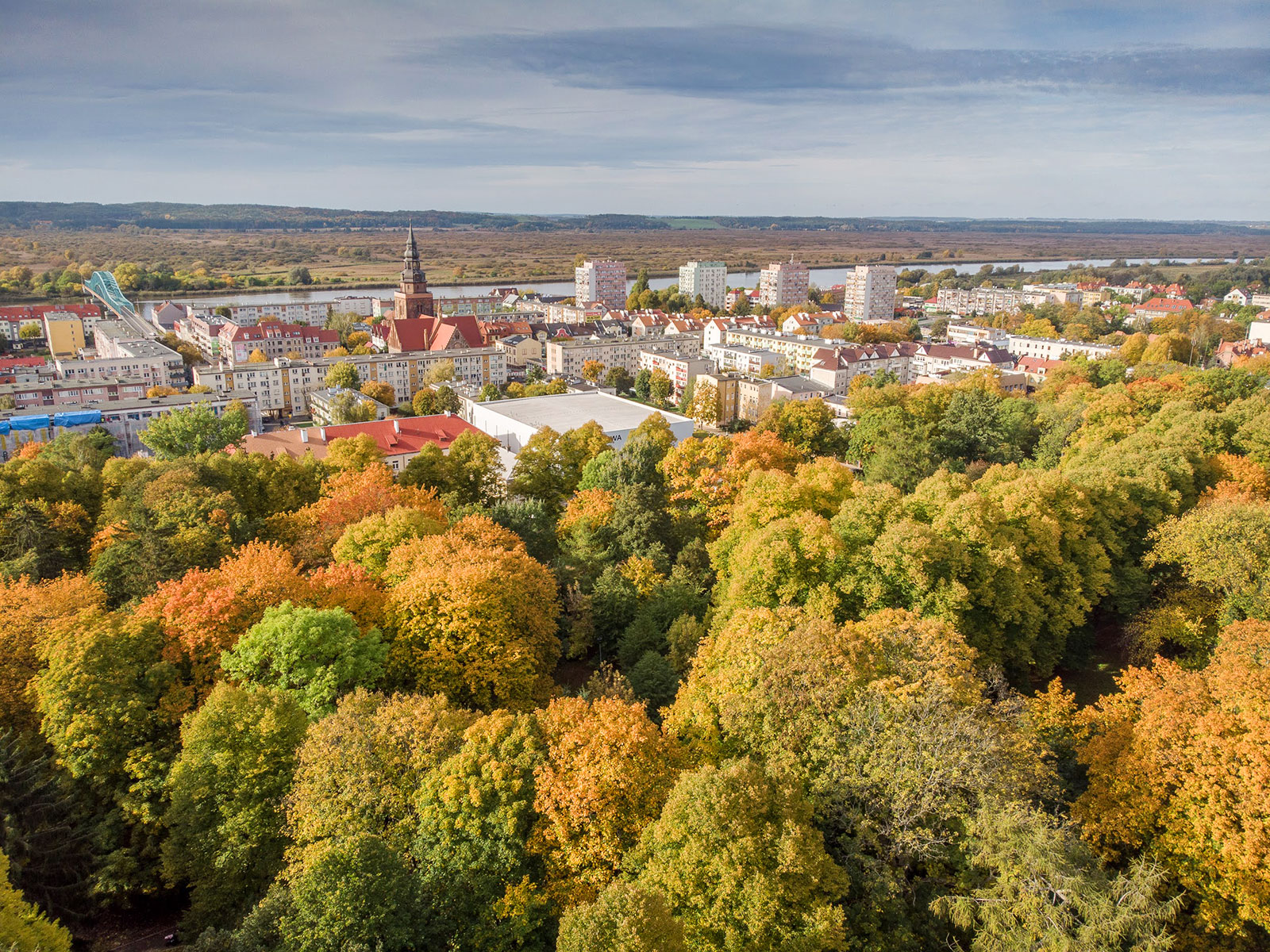 Center of Gryfino (source: Gryfino City and Commune Office)
Center of Gryfino (source: Gryfino City and Commune Office)
To understand the importance of Gryfino's actions, we need to first clarify one concept. Without this, we cannot move forward. I know theory can be boring, but don't worry, it will be interesting.
Has anyone ever heard of an urban heat island? Raise your hand if you have! Since you're reading this, I assume you're either raising your hand or smiling proudly right now. Great! For those who don't know what an urban heat island is, a quick explanation.
What is an Urban Heat Island?
Contrary to its rather pleasant name, an urban heat island is not a green islet in the middle of a city river. Gentle rays of sunlight do not caress us there after a bath. Such an island also has little to do with health – ours and that of the surrounding nature.
An urban heat island is a negative phenomenon that affects all cities. In short, it means that it is warmer in the city than in the surrounding area. One of the most spectacular examples of an urban heat island in the world is Tokyo. According to data from the Japan Meteorological Agency, the temperature rise in the Tokyo metropolis is faster than in other parts of the world. In the 20th century, the average ten-year temperature for September in Tokyo rose from around 21°C to over 24°C.
Why is this bad? Urban heat islands harm us. When it's very hot, we feel worse. The heat is especially oppressive in the city. It's not just about comfort, but above all about our health. Fainting, dehydration, heart attacks – these are the dangers that city dwellers, especially seniors, are exposed to on hot days.
Professor Krzysztof Błażejczyk of the Polish Academy of Sciences even conducted research indicating that urban heat islands probably have a significant impact on the increase in the incidence of heat stroke and exacerbate chronic respiratory and circulatory diseases.
What causes urban heat islands?
Why do cities become heat islands? There are three main reasons.
First, there are many artificial materials in the city (e.g., asphalt, concrete) that absorb sunlight and then release energy. This makes the surrounding area warmer.
Second, we heat up our little island ourselves. We use air conditioning, heat, drive cars, and produce various things.
Third, there is less greenery in cities than in the surrounding areas. Plants use the thermal energy they absorb and release water vapor. This cools the environment. A single large tree transpires 450 liters of water per day. It's a natural air conditioner. It is estimated that a rain garden absorbs 30-40% more water than a similarly sized lawn, which increases air humidity and improves the microclimate, especially during droughts.
The Art of Small Choices
It is not possible to completely eliminate the urban heat island. In the case of the first two points, it is rather difficult to imagine that a city will suddenly become a forest or that we will stop heating our homes. Cars will also be around (although engineers are still working on their emission-free versions), and we will continue to produce various goods. Air conditioning in the summer? If someone has experienced this comfort, they are unlikely to give it up.
In each of these aspects, we can minimize the risk at the level of personal choices. For example, we can choose a bus or a bicycle instead of a car. We can set the air conditioning one degree higher. We can also set a slightly lower temperature in our home in winter.
Greenery and Education
The project that the Gryfino commune implemented with the help of the EEA and Norway Grants primarily impacts the third reason for the formation of an urban heat island. The formal name of the project is: "Adaptation to climate change through the development of green and blue infrastructure in Gryfino".
In a nutshell, the officials, residents, and project partners - the Icelandic company Verkís:
- planted greenery together,
- learned from each other about the importance of greenery in the city and how to care for it,
- developed green recreational areas in Gryfino.
"The project's idea was not only to create new green spaces in Gryfino (...), but also to educate our society about the importance of greenery in the city, why we need it, and why we should take care of it" – explains Justyna Siwek-Matura, the project coordinator, in the project's promotional video (see below)
Video "Implementation of the Adaptation to Climate Change project" prepared by the Gryfino Commune
Why do we need greenery in the city?
As we've already established, urban greenery retains water and acts as a natural air conditioner. This, of course, works both ways, as the retained water nourishes the plants. If the plants didn't retain it, the polluted water would simply flow into the storm drains.
"Rainwater runoff from concrete surfaces collects a lot of sediment and dust. It is not useful for humans, so we use it for plants. They naturally filter this water for us, which is retained in the soil. Then the plants release this water back to us in the form of water vapor. This makes it easier for us to breathe on hot days" - explains Marta Klimowicz from the SOSENKA Nature Workshop in the project promotional video.
The function of green areas in the city is briefly described in the project summary video (see below) by Dr. Eng. Krzysztof Jankowski.
"Retaining water in the city is life for trees. If we are able to retain this water, then we are also able to maintain the vegetation. If we are able to maintain the vegetation, then the heat balance of the urban heat island that we have in every city center changes" - explains the scientist.
Video "Summary of the Adaptation to Climate Change project" prepared by the Gryfino Commune
These are not the only benefits of greenery in the city. Trees, shrubs, flowers, lawns and meadows promote biodiversity. Behind this difficult word lies the simple fact that they are a natural home for many animals, such as bees and other insects. Insects pollinate almost 90% of all flowering plants, which is essential for agriculture. Agriculture, of course, is food. This chain of dependencies leads from a small meadow to what we eat.
There is one more benefit of greenery in the city that is worth mentioning. It is our mental health. It has been proven that spending time in nature helps us to relax and thus improves our mental state.
Rest in Peace at the Cemetery
It's impossible to describe everything that was done as part of the project in a short text. However, let's take a look at a few of the projects.
We begin our tour of Gryfino at the cemetery, where you can rest in peace. This is not a joke, but a play of words that is very much intended.
"The new part of the municipal cemetery in Gryfino is located on a slight hill. The problem was that during heavy rains, water would flow down the cemetery in a large stream, flooding the fence and lighting points. Such places are ideal for rain gardens. The task of such a garden is to collect rainwater in flood-prone areas" - says project coordinator Justyna Siwek-Matura.
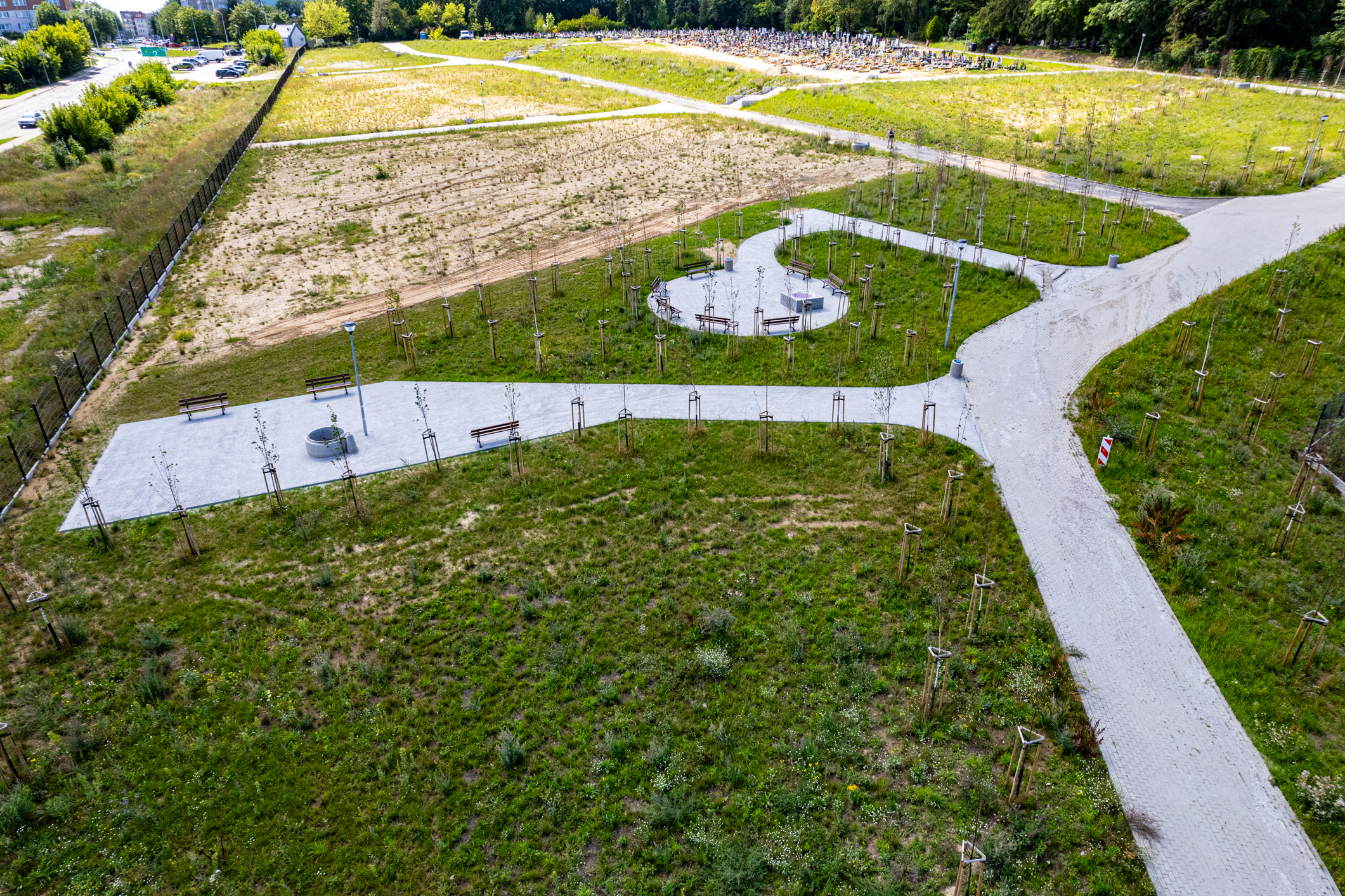 Development of a green square - a memorial site (source: Gryfino City and Commune Office)
Development of a green square - a memorial site (source: Gryfino City and Commune Office)
In the new part of the cemetery, 215 trees were planted, benches were installed, and a decorative memorial stone was erected. The officials also built infiltration wells and water collection points to irrigate this green area.
In this way, they killed three birds with one stone. They created a natural rain garden that retains water. They erected a beautiful, green wall separating the new cemetery area from the housing estate. They created a place where residents and cemetery visitors can relax and enjoy themselves.
Green Waterfront and Love Hill
There were definitely more such investments in the commune. For example, trees, grass, and perennials appeared on the Oder River embankment in Gryfino. When choosing plants, officials focused on varieties that are honey-producing and friendly to insects.
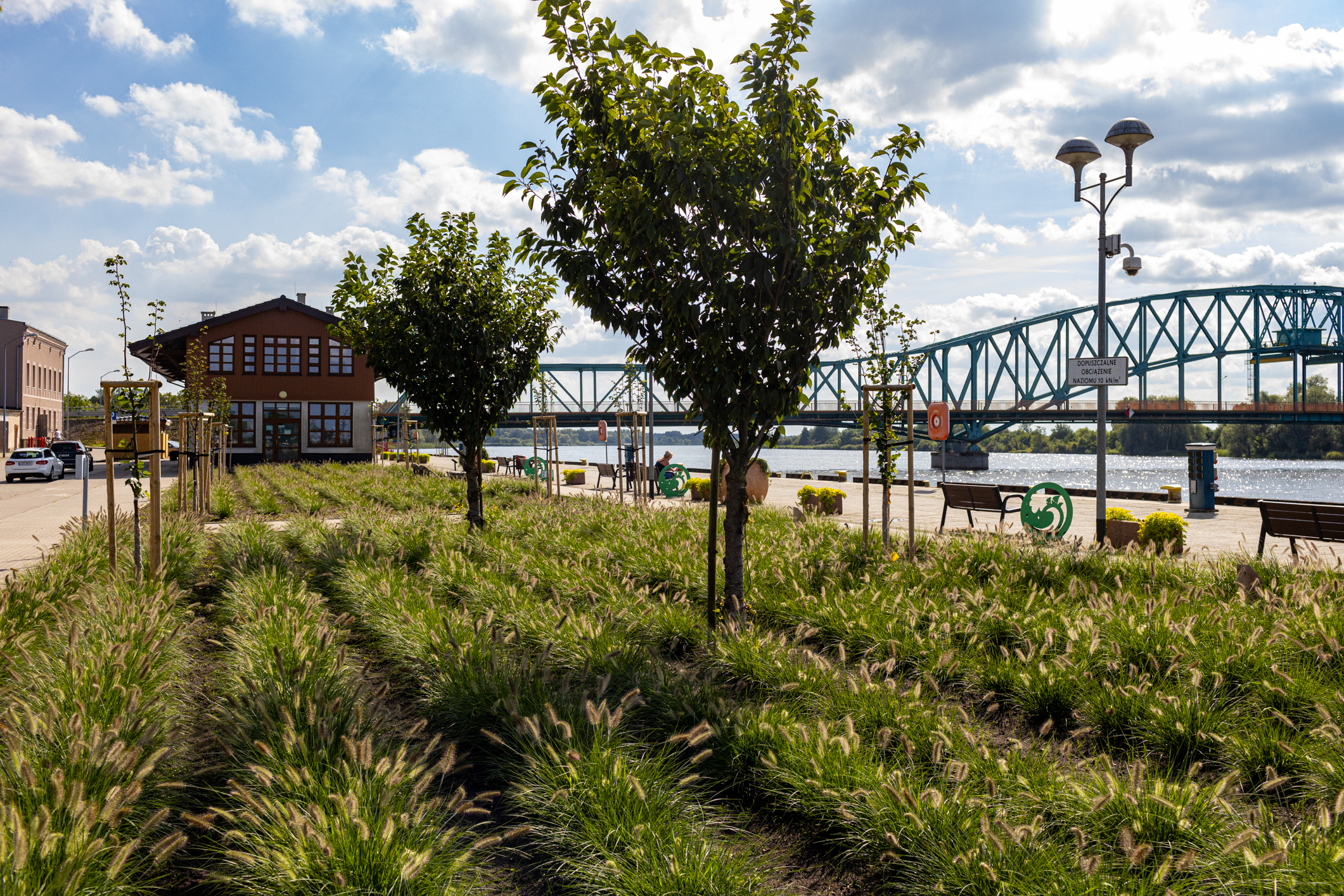 Development of the waterfront in Gryfino (source: Gryfino City and Commune Office)
Development of the waterfront in Gryfino (source: Gryfino City and Commune Office)
"The rain garden that we are creating on the Gryfino embankment is a model that can be used to create a garden next to your own home" - says Sunna Ósk Kristinsdóttir, project coordinator from the Verkis company, in a video from the project implementation.
New vegetation was also planted, among others, on "Opolanka" (recreational areas near Opolska Street), the square near the sports and entertainment hall, and an undeveloped area near the viaduct on national road no. 31.
Love Hill, a picturesque hill with numerous walking paths located in the vicinity of Gryfino, has also become a much nicer place. A wooden bridge was built there connecting Lovers' Square with the path leading to Meeting Square. Terrain stairs were also built on the escarpment from Armii Krajowej Street. In addition, invasive tree species were removed to protect old trees and improve the vegetation's ability to collect and purify water.
Love Hill is also an example of how to wisely combine different funding sources. In 2018, the commune beautified the hill with the help of European funds. Now it has continued its work using EEA and Norway Grants.
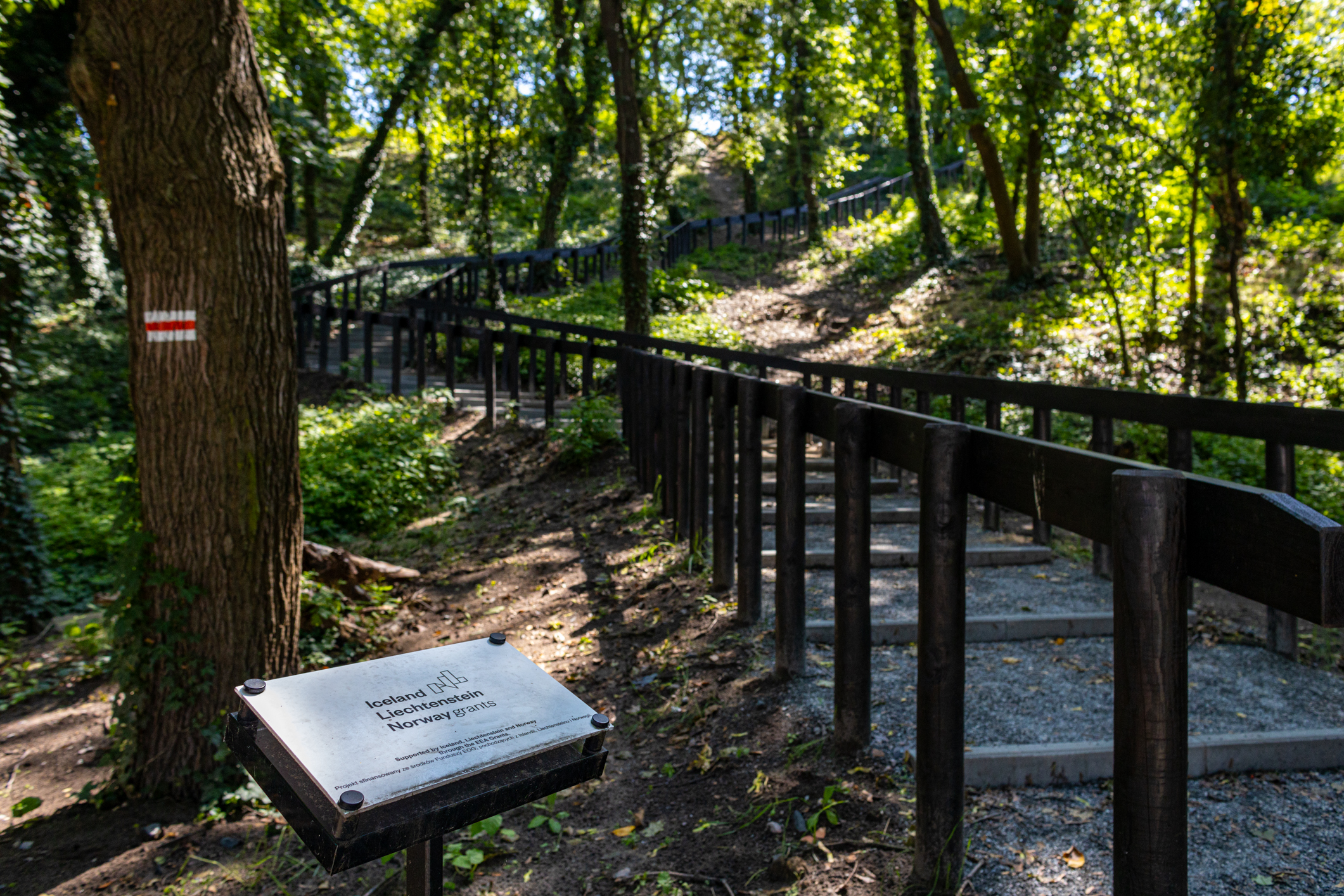 New field stairs leading to Love Hill (source: Gryfino City and Commune Office)
New field stairs leading to Love Hill (source: Gryfino City and Commune Office)
Educational Gardens: A Lesson in Responsibility
All of these investments would not make much sense without the second aspect of the project. This is about so-called "soft activities", which means education. Each of these activities is a kind of lesson in responsibility for the residents of the Gryfino commune.
An example of this is the Educational Gardens Programme. Thanks to it, students from Gryfino primary schools learned how to care for plants. 160 students from three primary schools in the Gryfino town area took part in the programme. Each school was given one green area to look after. The areas were equipped with gardening and irrigation equipment.
Students from Primary School No. 1 looked after the plants on the Gryfino waterfront, students from Primary School No. 2 took care of the trees and shrubs near the Gryfino Sports Hall, and students from Primary School No. 3 took care of the 215 trees planted on the aforementioned cemetery.
Isn't that a beautiful lesson in responsibility?
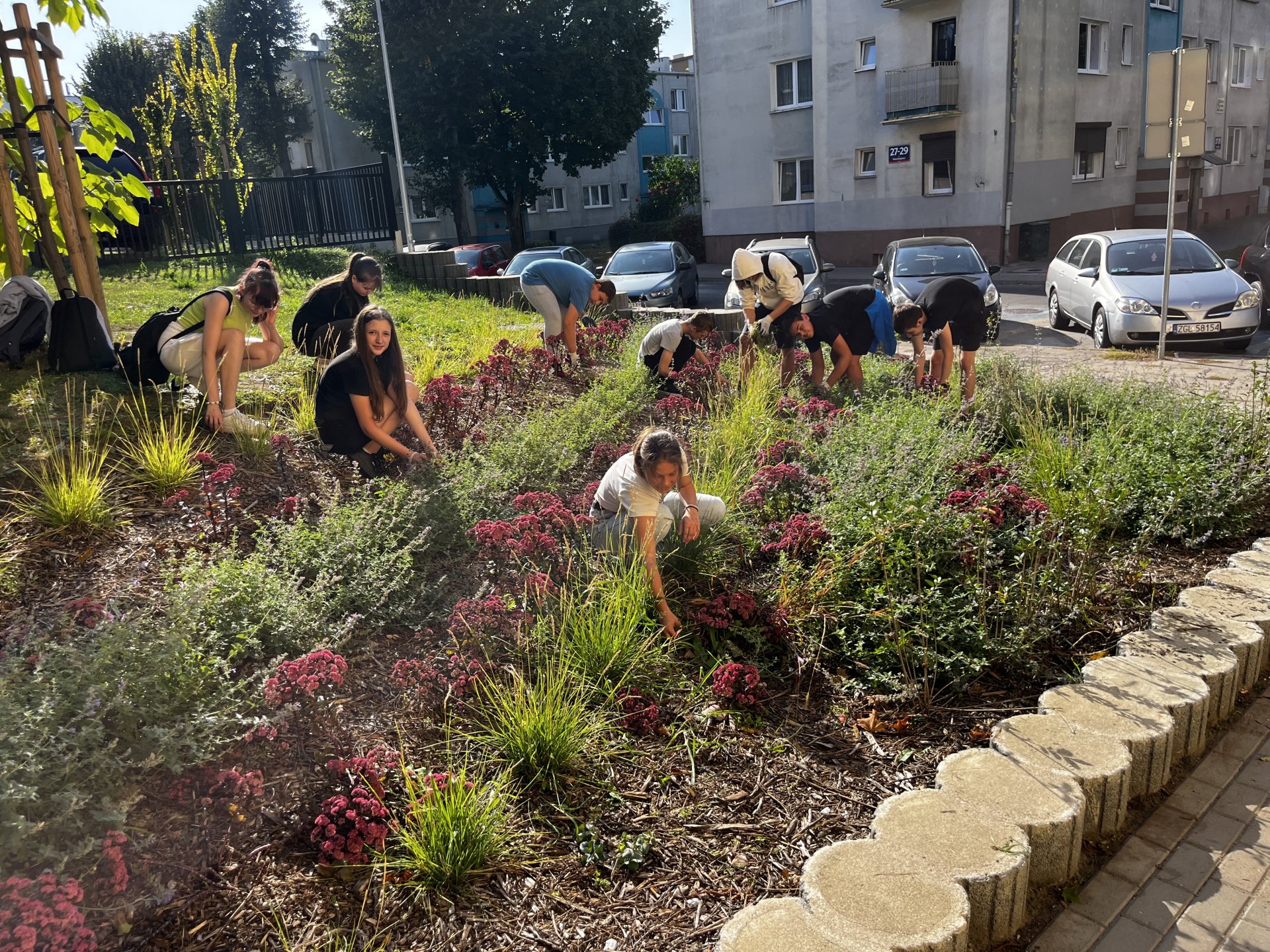 School educational gardens (source: Gryfino City and Commune Office)
School educational gardens (source: Gryfino City and Commune Office)
Rain Gardens: Lesson in Responsibility No. 2
Another interesting example is the training for commune residents on how to set up home rain gardens. It's a simple matter. You can talk for hours about how important water and greenery are in the city, but you also need to show people how to do it. This gives even more people - not just the commune - a chance to contribute to the fight against climate change.
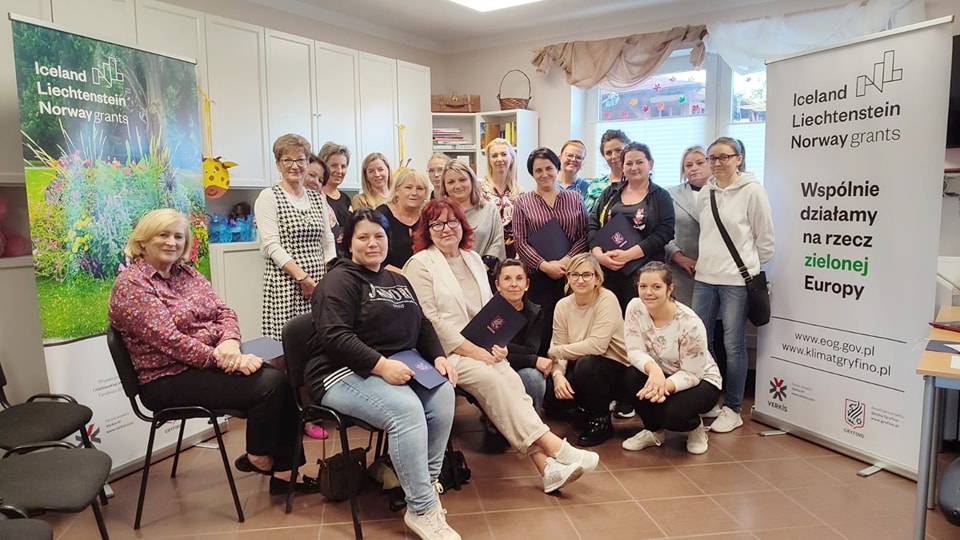
Participants of one of the training courses on establishing home rain gardens (source: Gryfino City and Commune Office)
200 people took part in the training sessions. They were held in village halls in Drzenino, Czepino, Stare Brynki, Sobiemyśl, Krajnik, Borzym, Wełtyń and the Gryfino City and Commune Office. As part of the training, this example rain garden was created on the waterfront, which you can read about a few paragraphs above. Training participants received educational materials on setting up rain gardens and seedlings of water-filtering plants suitable for rain gardens.
However, the training and the example garden are not everything. Children from kindergartens no. 1 "Krasnal Hałabała" and no. 5 "Calineczka" in Gryfino have created their own gardens!
In "Calineczka", the children planted 100 different types of plants under the supervision of instructors. In "Hałabala" 300 plants were planted! Another beautiful lesson in responsibility.
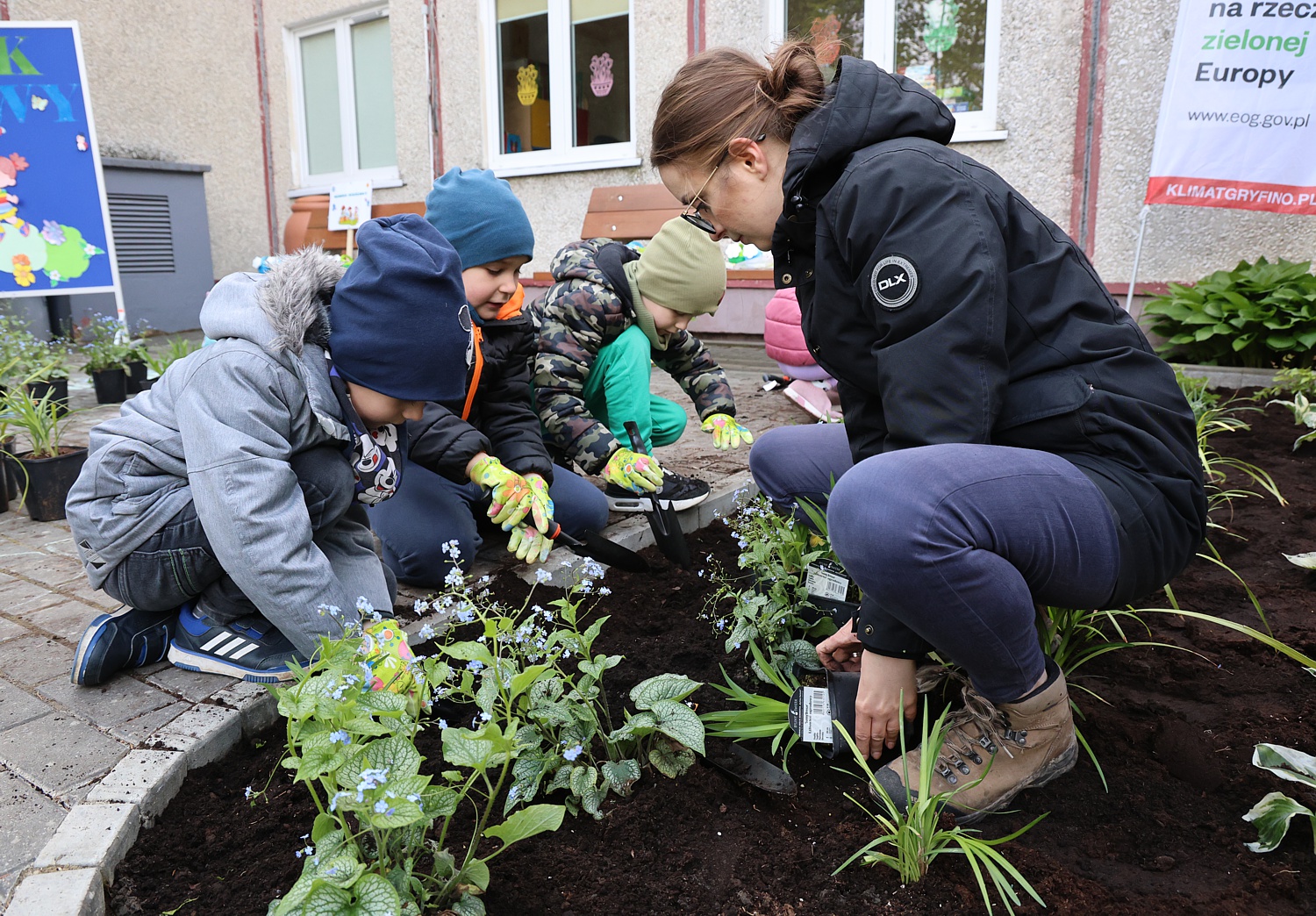 Preschoolers set up rain gardens at kindergartens (source: Gryfino City and Commune Office)
Preschoolers set up rain gardens at kindergartens (source: Gryfino City and Commune Office)
Adopt a Tree: Lesson in Responsibility No. 3
Have you ever heard of tree adoption? I never had. But in Gryfino, they've heard of it, and even 100 trees have found their parents.
The tree adoption programme was aimed at residents of the Gryfino Commune and created teach them responsibility for public green areas, and in particular, for the care of greenery. Residents of the commune adopted 100 trees. The commune signed three-year contracts with them. The contracts include obligations regarding the care of the adopted tree. The trees were marked with commemorative plaques with dedications chosen by the adopters.
Trees were adopted by, among others, seniors from the Senior+ Day Care Center, residents of the Gryfino Social Welfare Home, residents of Opolska Street, students from Gryfino primary schools and members of the "Ewa" Amazon Association in Gryfino.
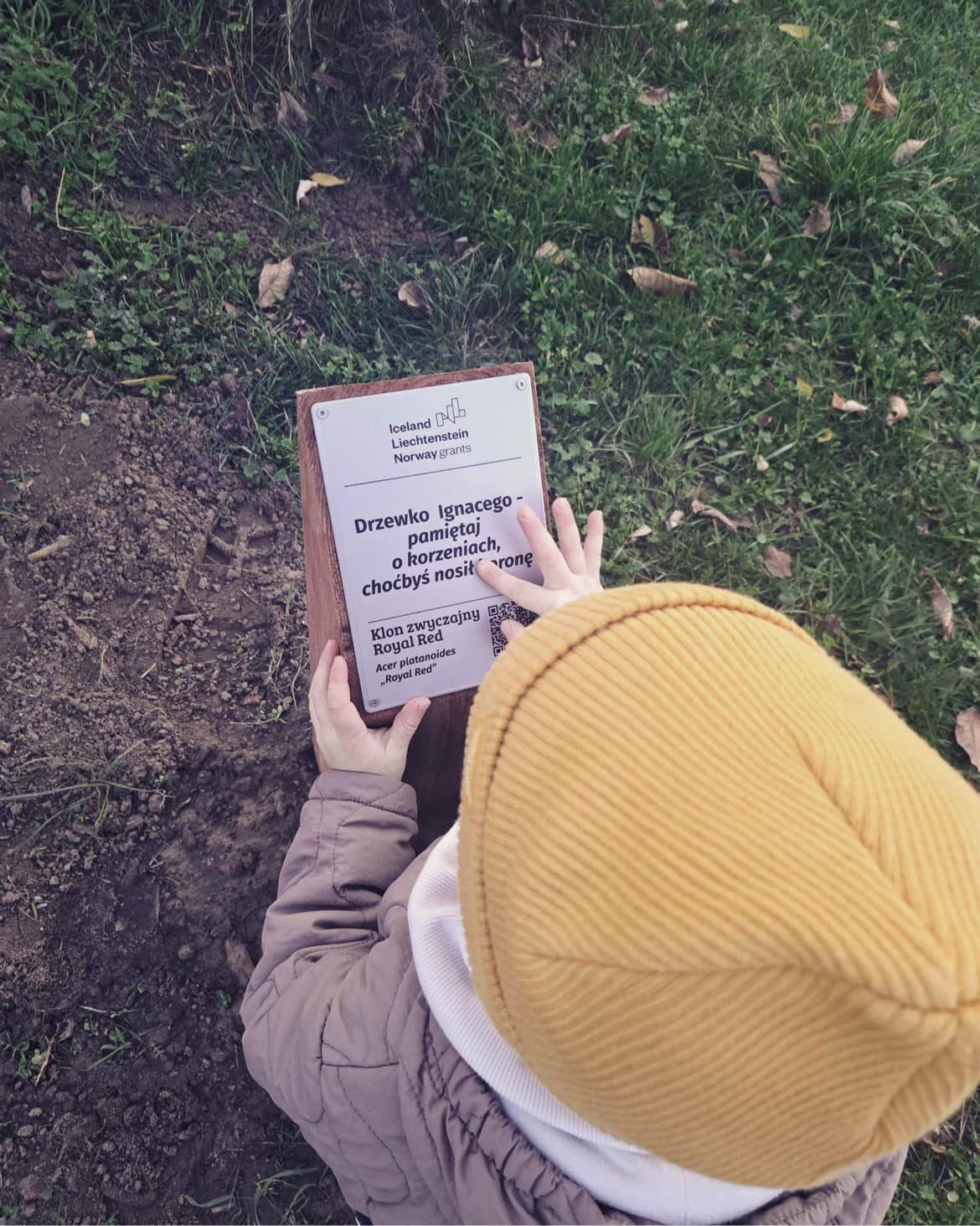
One of the adopted trees and a commemorative plaque (source: Gryfino City and Commune Office)
Chapeau Bas from the Author
One could go on and on about the project's results. The result would be a quite hefty book, because a lot was done with the help of EEA and Norway Grants.
Instead, I encourage you to visit the project's excellently run website. There you will find information about all the project activities, educational materials, and everything illustrated with a huge number of photos and films.
As someone who professionally promotes EEA and Norway Grants, I can only bow low and say "chapeau bas" to the website's authors.
About the Project
The project "Adaptation to climate change through the development of green and blue infrastructure in Gryfino" received over PLN 4 million in funding from the EEA and Norway Grants within the Environment, Energy and Climate Change Programme. The Programme operator is the Ministry of Climate and Environment.
Article Information
The author of the text is Paweł Nowak (Communication and Promotion Unit, Department of Assistance Programmes, Ministry of Development Funds and Regional Policy)

